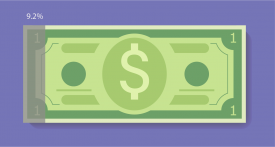How Does the Healthcare Industry Lower Prescription Drug Spending?
Amid the prescription drug debate, many are wondering if caps or rate negotiations can truly lower prescription drug spending. A Data Insight reveals how the industry might actually lower prices.

Source: Getty Images
- The exponential cost of prescription drugs has long been a debate in the United States. While many solutions have been proposed, few have been successful. From rate negotiations to pricing cap limits, no strategy to cut prescription drug spending has gained momentum.
Yet lawmakers across the aisle advocate for the reduction of costs as the US is one of the few developed countries without an explicit prescription drug pricing strategy.
“The U.S. is the only advanced society with no publicly accountable process to determine how much pharmaceutical drugs can be sold for. Every other leading nation uses the power of government to come to terms with this industry on pricing,” John McDonough, director of the Preparing for What’s Next in US Health Reforms, said in an interview with Harvard T.H. Chan School of Public Health. The program aims to provide lessons on industry reform and policy to healthcare leaders so they can understand the impact of these changes on their organizations.
With industry lobbyists in Congress’ ear, it is no wonder any comprehensive, nationwide strategy has yet to be successful. Industry lobby groups like PhRMA also argue that lowering the cost of drug prices would decrease their innovation potential. They state excess dollars from a new drug account for development costs and can be rolled over into research and development of new drugs.
But when a drug like Biogen’s aducanumab to treat Alzheimer’s disease has a $56,000 price tag, it’s hard to understand exactly what that surplus is funding.
In Medicare Part D, the top 50 drugs account for 43 percent of total spending but only 15 percent of all prescriptions.
Lawmakers must work to find the balance between lowering cost while maintaining innovation levels, but a policy for that sweet spot has yet to gain momentum.
Why are prescription drugs so expensive?
Nearly ten percent (9.2) of the national health expenditure is spent on prescription drugs, according to data from 2018. The same study reported $500 billion in total prescription drug spending, a number that is expected to increase by over $300 billion in the next ten years.
The biggest drivers behind these astronomical costs are new drugs—like aducanumab—and expanding use of existing, high-priced drugs. In other words, it’s all about the price tag.

Image adapted from data by Conti, R. et al, depicting the national expenditure on prescription drugs.
Source: Xtelligent Heatlhcare MediaNegotiations are limiting as many pharmaceutical companies say they need that higher price tag to make up for the cost of research and development. And lobbyist groups are quick to shut down any attempts at broadening competition in the market. Patent laws and limitations on generic competition see limited support in Congress.
Yet Medicare Part D covered 3,500 prescription drugs in 2019. This cost Medicare over $183 billion, a number that is not sustainable in an industry that repeatedly calls for lowering healthcare spending.
How does the industry lower costs?
A Data Insight from Xtelligent Healthcare Media dove into the relationship between drug pricing and other costs of care. Like other industry initiatives, lowering prescription drug costs is going to require leaders to think outside the box.
Using state-level Medicare Part D prescriber data and Medicare geographic variation data from CMS, Insights dove into understanding how increased—or decreased—drug prices would impact several other Medicare payments.
The total cost of care increased as prescription drug spending increased. For every additional prescription drug dollar paid, Medicare spent $1.47 more in total payments.
The total cost of care data was risk-adjusted to account for illness severity across the Medicare population. Regardless of how sick a patient is, the more Medicare spends on prescription drugs, the more they are spending in overall care.
Where is the excess spending going?
Insights analyzed the impact of increased drug costs on several specific areas of care, including:
- Inpatient
- Outpatient
- Ambulatory
- Inpatient rehabilitation
- Long-term care
- Home health
- Hospice
All payments were standardized to account for geographical variation.
Across all areas of care, payments were significantly less than prescription drug spending. For every dollar spent on prescription drugs, only six cents are spent on hospice payments. Ten cents are spent for home health, 11 cents for long-term care, and four cents for inpatient rehabilitation.
Growing spend is seen in inpatient and outpatient settings, but it is only 38 and 18 cents to every prescription drug dollar spent, respectively.
Total healthcare spend increases as prescription drug spending increases, but that excess money is not going toward these specific areas of care. That begs the question, where exactly is that money going?
Non-retail drug spending is included in the CMS data, but not on the Part D side. Part D prescription drug spending includes retail drugs or those filled at a pharmacy. These require authorization from a provider whereas non-retail drugs are those administered in a provider’s office or hospital. A patient does not have to go to a pharmacy to fill a non-retail drug order. These charges are included in the total cost of inpatient or long-term care payments, for example.
The dollars spent on prescription drugs over inpatient payments, therefore, do not include the cost of medications administered in the hospital. Therefore, the excess prescription drug spending is not going toward administration fees or hospital supplies.
Where the money is going is tied up in lobbyist groups, pharmaceutical developers, and the promise of innovation.
Are the industry’s priorities aligned?
Many medications are only effective if taken exactly as prescribed. With this rushed fee-for-service world limiting time during patient visits, it can be a challenge for many providers to ensure their patients understand their medication regimen and adhere to it.
Less than half (48.6 percent) of patients use at least one prescription drug during the day, but over 79 percent of emergency department visits and 73 percent of physician office visits involve drug therapy, according to CDC data.
Focusing on these areas of care that are paid less than prescription drugs such as inpatient rehabilitation and long-term care facilities might improve patient outcomes more. That is not to say that prescription drugs are unnecessary, but the healthcare industry—or at least CMS payments—are misaligned with what many patients actually need.
Rather than increasing retail drug expenditure and continuing to drive up the cost curve, payment should more robustly align with areas of care that can address a patient holistically. In a primary care visit, a doctor can prescribe a patient a drug but also address their anxieties, comorbidities, and underlying social determinants of health. Meanwhile, a retail drug can only be effective if taken properly by the patient, and that’s assuming patients are able to adhere to their medication regimen and are able to store the medication properly.
A drug that needs to be refrigerated is unhelpful to a patient lacking electricity. But in a primary care visit, a provider can learn a patient lacks electricity and work with community resources to change this fact. Yet the industry’s current payment structures place more emphasis on writing out prescriptions.
To truly impact prescription drug spending, the industry needs to realign its payment with its values and ensure those values focus on delivering the best patient care.
